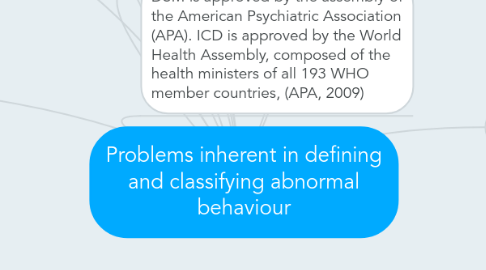Problems inherent in defining and classifying abnormal behaviour
저자: Lewis H

1. Mild cognitive disorder
2. Classified as rare or statistically unusual, certain cognitive disorders may not get taken into account, something that has been especially prevalent in foreign cultures/societies and ones within the UK throughout history, (ICD-10, F00-F99)
3. One observation is that in most societies, disruptive behaviour is seen as abnormal. This is what creates any specific society and differentiates one from another, (Pastorino & Doyle-Portillo, 2012, p 606).
4. ICD-10
5. Differences between ICD and DSM
6. Different cultures consider abnormal behaviour in different ways. Suicide, for example, is considered a devastating tragedy in the Western cultures, and those considering it or attempting suicide could be put under mandatory observation. However in some middle-eastern cultures, the religious implications of suicide raises the individual to martyr status.
7. Cultures
8. ICD is produced by a global health agency, the world health organisation (WHO), while DSM is produced by a single national professional association, (APA, 2009)
9. Impairment of memory, learning difficulties, and reduced concentration ability are some cognitive disorders that have been used to define abnormal behaviour, (ICD-10, F00-F99)
10. ICD's development is global, multilingual and multidisciplinary; however the primary constituency of the DSM is U.S. psychiatrists, (APA, 2009)
11. DSM is approved by the assembly of the American Psychiatric Association (APA). ICD is approved by the World Health Assembly, composed of the health ministers of all 193 WHO member countries, (APA, 2009)
12. DSM-V
12.1. Social anxiety disorder
13. In the past, social phobia primarily was diagnosed if an individual felt extreme discomfort or fear when performing in front of others. Research has shown that this definition is too narrow. With DSM-5, social anxiety can be diagnosed because of an individual’s response in a variety of social situations, (DSM-5, 2013)
14. Changes over time
14.1. The definitions and classification of what constitutes as abnormal behaviour constantly changes over time. In the past ten years there has been substantial changes, and in the past century there have been very big drastic changes; and in the future there will be many more to come. Abnormal behaviour in humans has been recorded as far back as biblical times. (Hansell, Damour, 2008)
14.2. The act of placing someone deemed mentally ill in a separate facility knows as an asylum dates back to 1547, when King Henry VIII of England established the St. Mary of Bethlehem asylum in London. (Susan, 2013)
14.3. As people in the middle ages and the renaissance believed in the devil and malevolent spirits, it was not uncommon for holes to be drilled into a patient's skull who was deemed possessed to release the spirit. These superstitious beliefs plagued the people of this time, and led to many misinterpretations of what we can now define in psychology as abnormal behaviour, (Selling, 1940).


